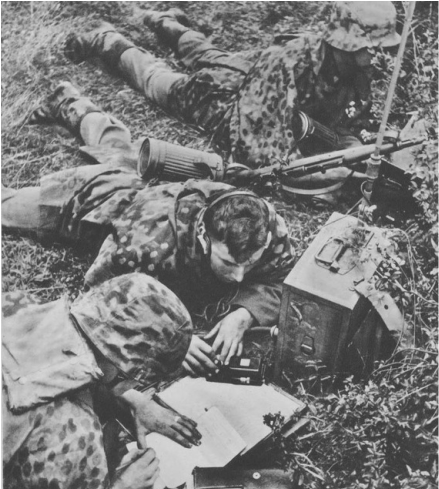The SS-Funker

The German field radios, or “Feldfunken”, were generally operated by so called “Funktruppes”. Depending on the equipment and type of radio used, these Truppes could be anywhere from two men to several dozen in size. A typical "Tornister Funktrupp", which would often be part of a Zugtruppe, or the command section of a Platoon, consisted of 2-4 men.
Generally, the members of the Funktrupp would be qualified radio operators, recognizable by the lightning bolt insignia on the Left sleeve. In a Tornister Funktrupp there would typically be a corporal commanding, with the other members being lower rank Funker.
Because most members of the truppe were qualified radio operators, they could all operate the set. How this was organized depended on the tactical situation. If the radio station had to be manned constantly, they would operate a shift pattern. In any case it was the Truppe commander's responsibility to ensure that tactical needs could be met. It would not be strange for one Funker to operate the equipment, while the other handled the messages.
The operator Funker would also listen in to the radio traffic to react to the transmission management codes or "Verkehrsziechen". But generally the message Funker would concentrate on the message content and decode it and transfer the message to the addressee. I mention addressee here because in most cases the Funktruppen were assigned to specific tactical commands, and their role would be to provide communication services for the commanding officer of that command.
In case of the Feldfunksprechers, things were at their simplest. The officer requiring the radio link would assign the Feldfunksprecher to his runner, who with minimal training could operate this simple device. (Feldfunk operators were generally not trained Funkers, and did not possess the lightning bolt insignia). The officer could listen in with the 2nd headset, but generally the Runner was kept at easy shouting distance as a radio antennas attract enemy fire and runners were often viewed as expendable. The officer would shout the message to his runner, who would transmit it and shout back the answer to his officer. In some cases, the officer would take the Feldfunksprecher himself, but probably only when he was not to be under observation from the enemy.
In 1939 the Waffen-SS adopted Waffenfarben, (Branch of Service Colors), with each branch of service being allocated a specific, identifying, waffenfarbe, with lemon yellow being chosen for Nachrichten, (Signals), personnel, which was displayed as piping on the shoulder straps. Enlisted Signals ranks shoulder straps indicate the ranks of, SS-Funker, SS-Oberfunker, SS-Sturmmann and SS-Rottenführer inclusively with the collar and/or sleeve insignia indicating the specific rank. The rank of SS-Oberfunker, is the senior funker.
Basic summary written and researched by:
SS-Rottenfuhrer Strauss,
SS-Funker, 2./SS-TK-I.R.1
Under Construction.. Check back for more information on the radios used by Funkers!
Generally, the members of the Funktrupp would be qualified radio operators, recognizable by the lightning bolt insignia on the Left sleeve. In a Tornister Funktrupp there would typically be a corporal commanding, with the other members being lower rank Funker.
Because most members of the truppe were qualified radio operators, they could all operate the set. How this was organized depended on the tactical situation. If the radio station had to be manned constantly, they would operate a shift pattern. In any case it was the Truppe commander's responsibility to ensure that tactical needs could be met. It would not be strange for one Funker to operate the equipment, while the other handled the messages.
The operator Funker would also listen in to the radio traffic to react to the transmission management codes or "Verkehrsziechen". But generally the message Funker would concentrate on the message content and decode it and transfer the message to the addressee. I mention addressee here because in most cases the Funktruppen were assigned to specific tactical commands, and their role would be to provide communication services for the commanding officer of that command.
In case of the Feldfunksprechers, things were at their simplest. The officer requiring the radio link would assign the Feldfunksprecher to his runner, who with minimal training could operate this simple device. (Feldfunk operators were generally not trained Funkers, and did not possess the lightning bolt insignia). The officer could listen in with the 2nd headset, but generally the Runner was kept at easy shouting distance as a radio antennas attract enemy fire and runners were often viewed as expendable. The officer would shout the message to his runner, who would transmit it and shout back the answer to his officer. In some cases, the officer would take the Feldfunksprecher himself, but probably only when he was not to be under observation from the enemy.
In 1939 the Waffen-SS adopted Waffenfarben, (Branch of Service Colors), with each branch of service being allocated a specific, identifying, waffenfarbe, with lemon yellow being chosen for Nachrichten, (Signals), personnel, which was displayed as piping on the shoulder straps. Enlisted Signals ranks shoulder straps indicate the ranks of, SS-Funker, SS-Oberfunker, SS-Sturmmann and SS-Rottenführer inclusively with the collar and/or sleeve insignia indicating the specific rank. The rank of SS-Oberfunker, is the senior funker.
Basic summary written and researched by:
SS-Rottenfuhrer Strauss,
SS-Funker, 2./SS-TK-I.R.1
Under Construction.. Check back for more information on the radios used by Funkers!
